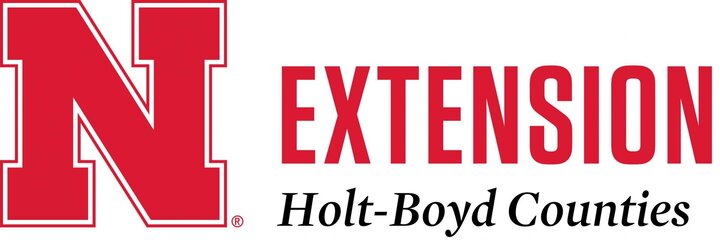
Nebraska Extension Educator - Holt/Boyd Counties - LaDonna Werth
Nebraska Extension Educator - Holt/Boyd Counties - Amy Timmerman
Nebraska Extension Educator - Brown/Rock/Keya Paha Counties - Brittany Spieker
Nebraska Extension Educator - Holt/Boyd/Garfield/Loup/Wheeler Counties - Bethany Johnston
Nebraska 4-H Assistant - Holt/Boyd Counties - Debra Walnofer
May 18: Holt County 4-H Shooting Sports .22 Rifle Practice, 2:00-6:00pm, Holt County Fairgrounds, Chambers, NE
May 18: Holt County 4-H Shooting Sports BB Gun Practice, 2:00-5:00pm, Holt County Fairgrounds, Chambers, NE
May 18: Holt County 4-H Shooting Sports Muzzleloader Practice, 2:00-6:00pm, Holt County Fairgrounds, Chambers, NE
May 18: Holt County 4-H Shooting Sports Shotgun Practice, 2:00-6:00pm, Holt County Fairgrounds, Chambers, NE
May 18: Holt County 4-H Shooting Sports Archery Practice, 2:00-4:00pm, Holt County Fairgrounds, Chambers, NE
May 28: DUE: Register for ServSafe Food Handlers Training, https://web.cvent.com/event/b20778cb-248b-410b-8421-a0bf92761e23/summary
June 1: DUE: State 4-H Horse Expo Online Entries and Horse I.D.s submitted to extension office https://4h.unl.edu/statewide-events-opportunities/horse-program/horse-expo/show-entry/
June 4: ServSafe Food Handlers Training, 8:30am-12:30pm, Holt County Annex Meeting Room
June 5: Workshop to Address the Spread of Cedar Trees and Control Options, 1:00–4:30pm, Holt County Courthouse Annex, O’Neill, NE
June 7: Holt County 4-H Shooting Sports Invitational, 8:00am, Holt County Fair Grounds, Chambers Nebraska
Get Ready to Preserve Your Summer Harvest
If you're preparing to preserve home-grown or freshly purchased foods during the growing season, start planning and learning now! Start by checking your equipment and supplies. Proper equipment in good condition is required for safe, high-quality home-canned food.
If you’ve not yet purchased your needed equipment, there are two types of canners to consider: boiling water and pressure canners. A boiling water canner is used for canning acid or acidified foods, including fruits, pickles, jams, and jellies. Boiling water canners cost about $30-$100 or can be assembled by yourself with a large stock pot with a secure lid, and a rack to keep jars off the bottom of the pot.
A pressure canner is essential for canning low-acid foods such as vegetables, meats, fish, and poultry. Temperatures inside pressure canners reach higher than boiling water canners (for example, 240°F and above as compared to about 212°F). This is necessary to follow the tested processes available to be sure and kill the toxin–producing spores of the bacteria Clostridium botulinum. If not killed, these spores can grow out and produce a deadly toxin (poison) in room-temperature stored jars of the low-acid foods mentioned.
You have two choices for your type of pressure canner: a dial gauge canner or a weighted gauge canner. Most steps in managing the
LaDonna Werth
Extension Educator
Phone: 402-336-2760
E-mail: lwerth2@unl.edu

pressure canning process are the same, but the two styles have different types of gauges to indicate the pressure inside the canner. Expect to spend $100-$150 or more on a pressure canner.
If you use a dial gauge canner, it is important to have the gauge tested for accuracy before each canner season or if you drop or damage your gauge. Testing of dial gauge canners can be done at many Nebraska Extension Offices across Nebraska. The testing usually has a minimal cost and takes a small amount of time. Testing information can be found at the Nebraska Extension food website: https://food.unl.edu. I would recommend that you call before arriving at your local Extension office to have your gauge tested.
For either type of canner, check that the rubber gasket is flexible and soft, and not brittle, sticky, or cracked which would indicate that it is needing to be replaced with a new gasket. Double-check that all openings, like vent ports, are completely clean and open.
You will want to inspect jars for any nicks or cracks as well as purchase new 2-piece canning lids. The flats MUST be new each time you home food preserves. If you are new to canning, new jars are a worthwhile investment (versus purchasing used jars from a yard sale or flea market). Mason-type jars of standard sizes (e.g., half-pint, pint, and quart) are recommended for the processing and research-based recipes will specify for “canning” style jars. When you get to canning your harvest, be sure to follow manufacturers’ instructions to prepare jars and lids.
In addition to standard cooking utensils like cutting boards and bowls, a jar funnel, jar lifter, headspace measurement tool, and bubble-freer are items that you will want to have handy for canning.
If you are planning to freeze your harvest, be sure to use packaging such as plastic bags or rigid containers that are intended for freezer storage of foods. Not all plastics are the same, and you want materials that will hold up to freezer temperatures as well as protect your goodies from damaging air and mixtures of odors.
Growing your own? You may be lucky enough to have previously started keeping garden records so you remember the name of that great tomato or pepper variety you have liked this past year. If not, think about planning to keep records this year. A garden journal might include variety, seed source, date planted, date harvested, notes on how it grew and resisted disease, and your personal evaluation of the crop.
A final must is reliable, up-to-date canning and other food preservation instructions. Very significant food safety risks are possible by following unsound recommendations or recipes. Only use reliable, up-to-date canning instructions available at the National Center for Home Food Preservation website: https://nchfp.uga.edu or at Nebraska Extension: https://food.unl.edu.
Source: Brenda Aufdenkamp - UNL Extension Educator (UNL For Families - May 11, 2025)
Soil Temperature as a Key Factor in Planting Decisions
Key Takeaways:
- Minimum Germination Thresholds Matter - Corn and soybean are safe to plant at ≥50°F soil temperature, and sorghum requires ≥55–60°F. Research shows corn can tolerate soil temps as low as 40°F without injury.
- Early Planting Can Increase Yield Potential - Planting during early soil-warming windows, especially in irrigated fields, maximizes yield potential but must be balanced with crop insurance eligibility dates.
- Residue Type Affects Soil Warming - Wheat stubble (dryland) warms faster than corn or soybean residue (irrigated), which retain cooler temps.
- Soil Moisture Influences Germination Speed and Chilling Risk - Adequate soil moisture is essential for rapid seed imbibition, making it even more important to time planting with both temperature and moisture conditions to support strong emergence.
- Soil Temperature Sensors Help Optimize Timing - Using sensors and data loggers gives real-time, site-specific insights, helping growers act during short planting windows while minimizing risk.
Minimum Planting Temperatures for Early Planting
Amy Timmerman
Extension Educator
Phone: 402-336-2760
E-mail: atimmerman2@unl.edu

Traditionally, farmers in the west-central Nebraska region wait until the risk of severe frost has passed and the soil has warmed sufficiently to ensure vigorous germination and emergence of corn, soybean and sorghum. The average soil temperatures for which proper seed germination is guaranteed are 50°F for corn and soybeans, and between 55-60°F for sorghum. Even so, records indicate that temperatures close to 40°F for corn would not generate a harmful impact on the corn crop.
With research advances suggesting that early planting can maximize crop yield potential and therefore return on crop input investments, farmers are often dealing with planting into cold conditions. Exploring the potential advantages of adjusting the planting schedule in west-central Nebraska could offer new strategies to optimize agricultural production in the region.
With this objective in mind, students from the Cropping Systems Lab at the West Central Research Extension and Education Center (WCREEC) in North Platte, Nebraska installed soil temperature sensors in early April to track daily soil temperature changes and carry out early planting of corn, soybean and sorghum as soon as the minimum temperature for germination is reached.
Sensor Installation: Method, Location and Experimental Context
The sensors were installed at an average planting depth of 1.75 inches to represent the soil temperature to which the seed would be exposed during germination. Each sensor was connected to a datalogger, which provided online access to hourly soil temperature changes on a phone or laptop.
Three fields with the most common crop residue for planting corn, soybean and sorghum were selected to install soil temperature sensors. These fields were wheat stubble in dryland (wheat-corn), corn residue under irrigation (corn-soybean), and soybean residue under irrigation (soybean-corn or soybean-sorghum). Sensors were installed on April 4, and this article shows soil temperature measurements until May 4.
Analysis of Temperature Records
Overall, the wheat residue on the dryland field had the highest daily soil temperature on most days. Corn residue in the irrigated field had the lowest soil temperature. April 9 was the first day average soil temperatures reached 50°F - the minimum temperature to plant corn and soybean. After that day, there were at least three periods of three days with temperatures above 50°F and long enough for corn and soybeans to be planted and pass the imbibition critical face for chilling injury.
Overall, soil temperature had not reached a minimum sorghum temperature for a considerable period of time, which usually occurs in mid-May.
Final Considerations
Planting early is a pre-condition for achieving high corn and soybean yields, especially in irrigated fields. Our information shows that there have already been three good early planting windows for corn and soybean. However, based on USDA Risk Management Agency (RMA) crop insurance standards, the earliest corn planting date was April 10 for corn and April 25 for soybeans in the North Platte, Nebraska precinct for fields still eligible for a replant payment.
Producers are encouraged to include insurance guidelines before finalizing crop planting date decisions. Other management decisions, such as applying seed fungicide treatments, were not included in this study but may be advised under wet spring and early planting conditions.
Overall, field-stored soil moisture has been in the lower range of historical records in 2025. Rainfall has been 2 inches less than the 30-year average of 5 inches for January through April.
Besides temperature, soil moisture at planting is a key factor for good emergence. If good moisture is available, the imbibition phase of germination will occur faster than with low soil moisture content. A faster imbibition phase will reduce the possibility of chilling injury.
Minimum air temperature and frost forecast are often seen as a reference for starting to plant, rather than looking at soil temperature at seed planting depth. This could lead to a delay in planting and yield potential losses. The possible last spring frost crop injury probability has been published in a May 1 CropWatch article.
While aboveground freezing temperatures can occur even after planting, this does not directly affect the underground planted seeds. Our soil temperature experiment records for April 15, April 19 and April 27 show average soil temperatures below 50°F, and the minimum soil temperatures on these days were 41°F, 41°F and 47°F without causing injury to planted seeds.
Finally, it is important to remember that seed emergence will take 12-23 days for corn and 13-25 days for soybean when planted in late April to early May, based on our planting date experiment in North Platte over the last two years at WCREEC.
Source: Marcos Ventura - Research Scholar, Matias Gabilan - Research Scholar, Tiago Facco - Research Scholar, Muhammad Ahmad - Postdoctoral Research Associate, Ruby Collins - Extension Educator, Todd Whitney - Extension Educator, Nicolás Cafaro La Menza - Cropping Systems Specialist, Department of Agronomy and Horticulture (CropWatch - May 6, 2025)
What Can We Do About Late Calvers and the Upcoming Breeding Season?
Producers can take several steps to encourage cows to return to estrus faster after calving, boosting conception rates and ensuring calves are born earlier in the next calving season. Cows cycling early in the breeding season have higher pregnancy rates, leading to uniform calves and increased weaning weights.
To maintain a yearly calving interval, beef cows must recover from the nutrient and physical demands of calving and lactation and will have 80 to 85 days to return to estrus after calving to potentially maintain a yearly calving interval. Failure to successfully manage the post-partum interval is one of the major causes of reproductive loss, especially in young cows.
Key Strategies to Manage Calving and Breeding
Body Condition Score (BCS):
Cows with BCS ≥ 5 at calving are more likely to cycle and conceive earlier.
Nutritional management is crucial; cows losing weight post-calving are less likely to return to estrus.
Temporary Calf Removal:
Separating calves for 48 hours can trigger estrus in moderately conditioned cows (BCS 4–5).
Early or complete weaning may be required for thin cows (BCS < 4).
Bethany Johnston
Extension Educator
Phone: 402-336-2760
E-mail: bjohnston3@unl.edu

Controlled Internal Drug Release (CIDR):
Progesterone devices can "jump-start" estrus in cows ≥ 20 days post-calving.
Useful for estrus synchronization in both artificial insemination and natural service.
Bull Exposure:
The presence of a bull sometimes shortens the post-calving interval to estrus.
Nutritional Support:
Provide the proper balance of protein and energy in diets before and during the breeding season to support the maintaining of cows in adequate body condition and weight gain for cows less than a body condition score of 5. Proper nutrition promotes the resumption of estrus and can improve conception rates.
Shortened Breeding Season:
Encourage cows to calve earlier by limiting the breeding season, which increases pressure to conceive sooner.
Why Manage Late-Calving Cows?
Managing late-calving cows is crucial to reduce reproductive risks and economic losses in fixed-breeding seasons. These cows often struggle with delayed conception and lower productivity.
Benefits of Early Calving
Early-born calves exhibit higher weaning weights and superior reproductive performance. Early-calving cows have more opportunities to conceive in subsequent breeding seasons, enhancing herd efficiency and profitability.
Resources to consider this upcoming breeding season
Tools like the "Breeding Cost Cow-Q-Lator" can help producers calculate and compare expenses for different strategies. Another resource that allows producers to compare costs of protocols and generate calendars specific to timing of synchronization drugs, CIDR insertion and removal, and when to artificially inseminate is the Estrus Synchronization Planner.
Source: Kacie McCarthy, Nebraska Extension Cow-Calf Specialist, Aaron Berger, Nebraska Extension Educator (BeefWatch - May 1, 2025)
News Release
Keep Your Home-Canned Foods Safe
If you’re planning to preserve your garden harvest this year, now is the time to make sure your pressure canner is in top working order.
Nebraska Extension is hitting the road with its Pressure Canner Testing Roadshow, offering free dial-gauge pressure canner testing at several locations across north central Nebraska. Home canners are encouraged to stop by, meet Extension Educator Brittany Spieker, and ensure their equipment is safe to use.
“Pressure canners with dial gauges should be tested at least once a year,” said Spieker, who serves as the Food, Nutrition, and Health Extension Educator for the region. “Even what seems like a small inaccuracy in the gauge can lead to unsafe or poor-quality food. This quick test can protect your health and your hard work.”
TESTING SCHEDULE:
| Date | Time | Location | City |
|---|---|---|---|
| Wednesday, May 28 | 9:00-11:30am | Holt County Extension Office | O’Neill |
| 1:30-4:00pm | Boyd County Extension Office | Butte | |
| Thursday, May 29 | 8:30am-12:00pm | BKR Extension Office | Ainsworth |
| 1:00-4:30pm | BKR Extension Office | Ainsworth | |
| Friday, May 30 | 9:00am-12:00pm | Cherry County Extension Office | Valentine |
Canners may be dropped off in advance at the location where testing is scheduled or brought in during the listed hours.
During this quick test, Spieker will:
- Check the dial gauge using a professionally calibrated master gauge to ensure it reads accurately.
- Inspect the sealing ring for cracks, brittleness, or improper fit.
- Examine the vent pipe, air vent, and the overpressure plug to ensure they are clean and clear, ensuring proper function.
- Assess the overall condition of the lid and canner body for wear or damage.
Can’t make it to the roadshow? No problem - pressure canners can be tested any time of year. Just contact your local Extension Office to schedule an appointment ahead of time.
For more information about the Pressure Canner Testing Roadshow or to arrange a canner drop-off, call your local county Extension office.
Have questions about canning? Reach out to Brittany by calling (402-387-2213) or emailing (bspieker2@unl.edu).
NEWS RELEASE
WORKSHOP TO ADDRESS THE SPREAD OF CEDAR TREES AND CONTROL OPTIONS
Cedar trees are rapidly spreading across Nebraska’s grasslands, threatening valuable forage for grazing animals and habitat for wildlife. In some areas, grass production has dropped by as much as 75% over the past three decades due to cedar tree encroachment. The best time to control your cedar trees is now!
To help landowners and producers tackle this issue, a hands-on workshop will be held on Thursday, June 5, from 1:00 to 4:30pm CT at the Holt County Annex Building, located at 128 N 6th Street, O’Neill.
Gain insight from real-life examples of various cedar control projects, including before/after photos, cost of the projects, cost-share options, and how producers are maintaining cedar-free pastures to maximize grass. Understanding how cedar trees spread, and grow will help producers decide the best control options to use. Learn how to keep your prescribed burn contained to the unit - as slope, tree height, piles, weather, crew/equipment can be mitigated to ensure a safe and controlled burn. A member from the Prescribed Burn Association will share firsthand experiences and practical advice from their prescribed burns.
Walk-ins are welcome, but registrations are appreciated. Call the Holt County Extension Office at 402-336-2760 or email Bethany at mailto:bjohnston3@unl.edu.
Thanks to these partners: Nebraska Extension, Pheasant Forever, the Nature Conservancy, Sandhills Task Force, Nebraska Game & Parks, US Fish and Wildlife, and NRCS
